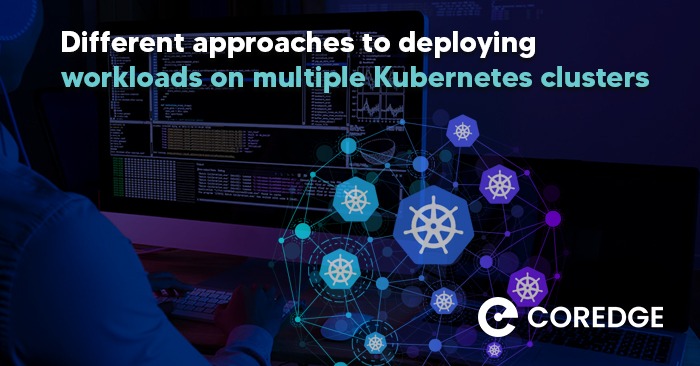Different Approaches to Deploying Workloads on Multiple Kubernetes Clusters
Coredge Marketing
October 14, 2022

Introduction
In Kubernetes, workloads can be segmented in different ways. You can easily do that if you want to run them in different pods or create different namespaces. However, if you want to achieve the maximum level of accuracy as well as a high level of availability and performance, it is advisable to opt for a multi-cluster Kubernetes deployment.
This blog explains how to deploy and manage your workloads on multiple Kubernetes clusters.
Understanding multi-cluster deployments
Talking about the containerized Kubernetes environments, it is important to understand that they can differ in a number of directions. They can be a single or a multi-cluster. According to a survey by CNCF, 92% of respondents have adopted containers in their production environment, while 83% of them use Kubernetes to orchestrate those containers.
Multi-cluster Kubernetes deployment is a method that comprises two or more clusters. The deployment of a multi-cluster setup is highly flexible. Different hosts in a single data center may host different clusters.
This actually results in a development in Kubernetes containerization from single cluster to centralized multi-cluster to distributed multi-cluster to, finally, multi-region edge deployments, which often track application maturity. The real magic for users and organizations happens right at the edge.
Approaches to deploying workloads on multiple Kubernetes clusters
There are many ways to deploy and manage your workloads on multiple Kubernetes clusters.
1. Manual approach
The so-called DIY (do it yourself) method, which involves manually setting up several clusters, is the easiest. This approach needs the most work, but it offers you the most flexibility in terms of where and how the clusters are maintained. Almost any cloud or private data center can be used to build up the clusters, and any platform that supports multi-cluster management can be used to monitor them which Coredge.io does for clusters running on most types of infrastructure and multi-clouds.
2. Using a multi-cluster management platform
The next approach is to use a Kubernetes management platform that can support multiple clusters.
CloudCompass by Coredge is the prime example here. CloudCompass is not a Kubernetes distribution; it doesn’t provide its own implementation of Kubernetes or require you to configure your clusters in a specific way. Instead, CloudCompass Controller allows you to easily deploy, create, manage, monitor, and upgrade, a number of Kubernetes clusters across any geo-locations, on-premises, bare metal, multiple clouds, and edge environments. It helps you to deploy clusters on virtually any infrastructure of your choice – may it be a public cloud, or a private data center, and manage them all through the Compass control plane. Compass helps to manage your multi-clusters remotely.
With CloudCompass, you can manage all of these clusters and versions centrally, while also enjoying granular control over versioning.
CloudCompass provides certifications and testing, policy and governance, disaster recovery, observability, and multi-cluster lifecycle management.
Manage your workloads better with the right Kubernetes Day 2 solution
Multi-cluster Kubernetes has several advantages, especially for teams that work on a large scale or those who want to separate their workloads strictly. But choosing the right cluster management solution that enables you to manage multi-clusters effectively is essential if you want to get the most out of a multi-cluster approach.
Connect to us today to leverage multi-cluster deployment and management for your workloads.





